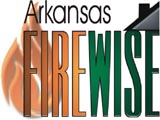

Next, dress properly to prevent burns and lifelong scars. Wear long pants, cotton or wool long-sleeve shirts or jackets. Gloves and a damp cloth provide added protection. Do not wear short sleeve shirts or clothing made of synthetic fabrics.
If there is time before the fire arrives, take the following actions:
Emergency Wildfire Survival Checklist
Preparing to Evacuate
- Park your car in the garage, heading out with windows closed and keys
in the ignition.
- Close the garage door but leave it unlocked; disconnect the automatic garage
door opener in case of power failure.
- Place valuable documents, family mementos and pets inside the car in the
garage for quick departure, if necessary.
- If you do evacuate, use your pre-planned route, away from the approaching
fire front.
- Keep a flashlight and portable radio with you at all times.
- If you are trapped by fire while evacuating in your car, park in an area
clear of vegetation, close all vehicle windows and vents, cover yourself with
a blanket or jacket and lie on the floor.
- If you are trapped by fire while evacuating on foot, select an area clear
of vegetation along a road, or lie in the road ditch. Cover any exposed skin
with a jacket or blanket. Avoid canyons that can concentrate and channel fire.
Outside Your Home
- Move combustible yard furniture away from the house or store it in the garage;
if it catches fire while outside, the added heat could ignite your house.
- Cover windows, attic openings, eave vents and sub-floor vents with fire
resistive material such as 1/2-inch or thicker plywood. This will eliminate
the possibility of sparks blowing into hidden areas within the house. Close
window shutters if they are fire resistive.
- Attach garden hoses to spigots and place them so they can reach any area
of your house.
- Fill trash cans and buckets with water and locate them where firefighters
can find them.
- If you have an emergency generator or a portable gasoline-powered pump that
will supply water from a swimming pool, pond, well or tank, clearly mark its
location and make sure it is ready to operate.
- Place a ladder against the house on the side opposite the approaching fire
to help firefighters in rapidly getting onto your roof.
- Place a lawn sprinkler on flammable roofs, but don't turn it on unless the
fire is an immediate threat. You do not want to reduce the supply of water
for the firefighters.
Inside Your Home
- Close all windows and doors to prevent sparks from blowing inside.
- Close all doors inside the house to slow down fire spread from room to room.
- Turn on a light in each room of your house, on the porch and in the yard.
This will make the house more visible in heavy smoke or darkness.
- Fill sinks, bathtubs and buckets with water. These can be important extra
water reservoirs.
- Shut off liquefied petroleum gas (LPG) or natural gas valves.
- Move furniture away from windows and sliding glass doors to keep it from
igniting from the heat of fire radiating through windows.
- Remove your curtains and drapes. If you have metal blinds or special fire
resistant window coverings, close them to block heat radiation.
If You Stay in Your Home When a Fire Approaches
- Stay inside your house, away from outside walls.
- Close all doors, but leave them unlocked.
- Keep your entire family together and remain calm. Remember: if it gets hot
in the house, it is many times hotter and more dangerous outside.
After the Fire Passes
- Check the roof immediately, extinguishing all sparks and embers. If you
must climb onto the roof, use caution, especially if it is wet.
- Check inside the attic for hidden burning embers.
- Check your yard for burning woodpiles, trees, fence posts or other materials.
- Keep the doors and windows closed.
- Continue rechecking your home and yard for burning embers for at least 12
hours.